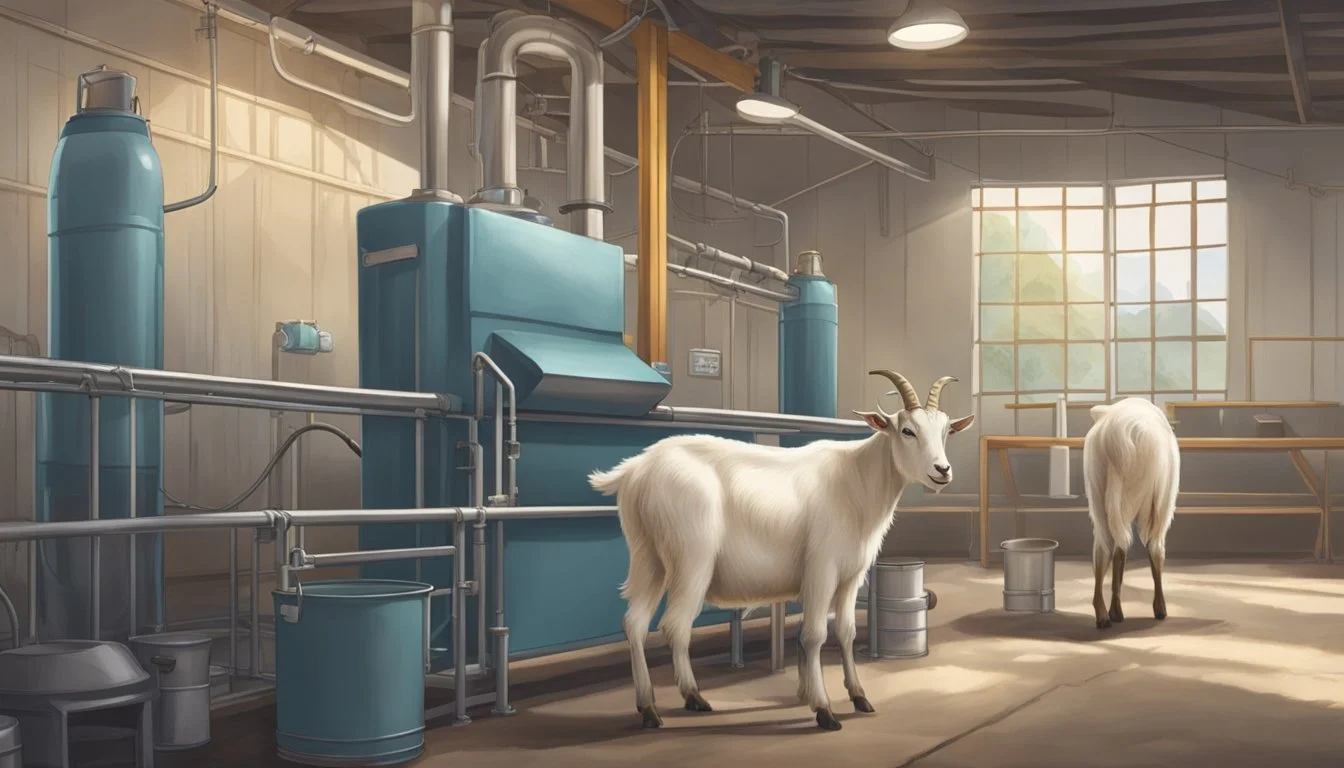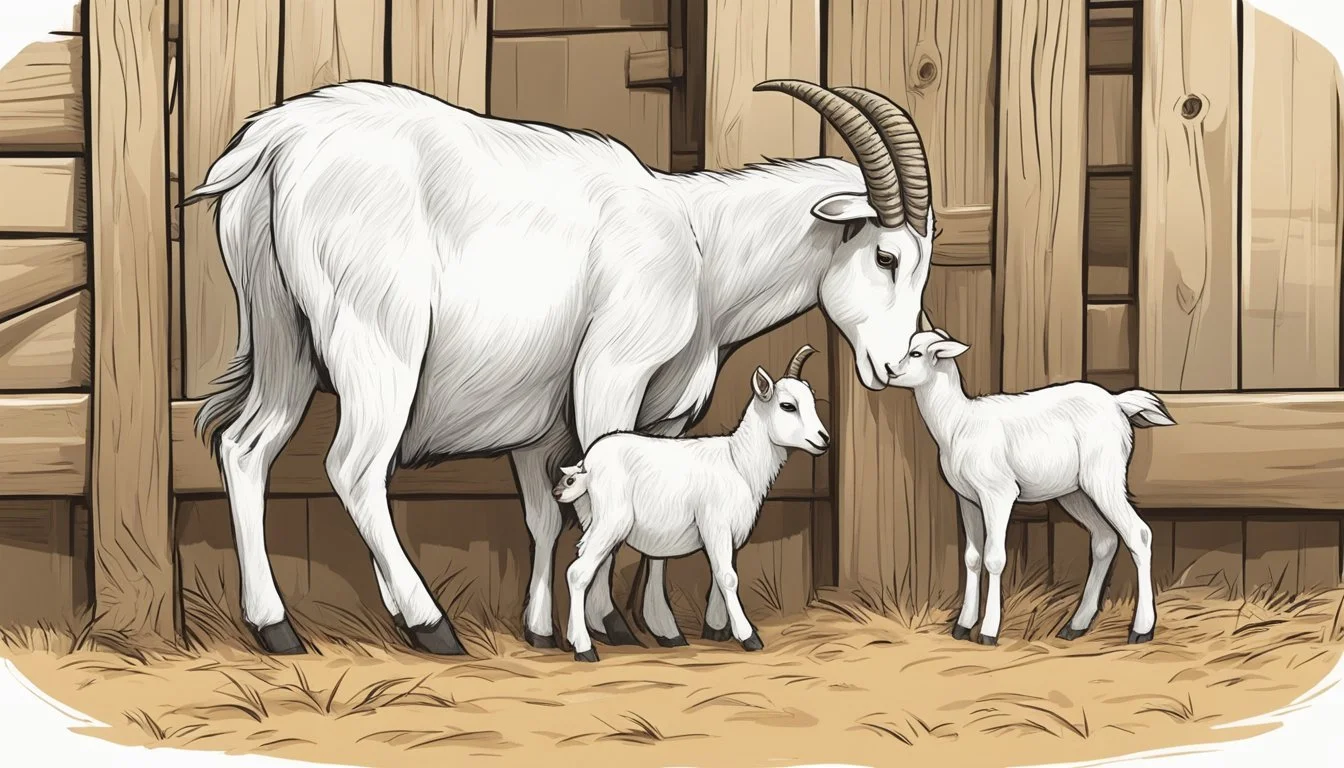The Importance of Record Keeping for Your Family Milking Goat
Key Benefits and Strategies
Efficient record keeping plays a crucial role in managing a family milking goat operation. It allows for the meticulous tracking of each goat's health, milk production, breeding cycles, and overall well-being. By maintaining detailed records, goat owners can make informed decisions that directly impact the productivity and profitability of their herd. Accurate records also serve as invaluable tools for monitoring the genetic lineage and the effectiveness of different milking routines, while also ensuring compliance with health regulations.
The health of a milking goat is paramount to the success of a homestead dairy. A systematic approach to record keeping ensures that all vaccinations, deworming treatments, and veterinary visits are documented and easily accessible. This comprehensive history assists owners in identifying patterns in health issues, managing disease outbreaks, and ensuring that each individual goat receives appropriate and timely medical care. Additionally, records of milk production can highlight trends, pinpoint problems, and provide evidence of the goat's value over time.
When it comes to breeding, detailed records become indispensable. They help track the goat's reproductive history, including heat cycles, breeding dates, and kidding records. Such data contributes to better breeding decisions and improved herd genetics. Owners who practice diligent record keeping are better positioned to manage their resources effectively, plan for future milk production needs, and cultivate a healthy, productive, and sustainable milking goat herd.
Essentials of Goat Record Keeping
Successful management of a family milking goat hinges on meticulous record keeping. This process encompasses various aspects necessary for maintaining a healthy, productive, and profitable dairy goat operation.
Setting Up Your Record System
Firstly, it is crucial to establish a record system that caters to the specific needs of your dairy goat farm. Utilizing a notebook for manual entries or a spreadsheet for a digital alternative grants the flexibility to adapt records as you scale your herd.
Key Records to Maintain
Several key records must be diligently updated to manage a goat farm effectively. This includes identification details like ear tags or tattoos, and production records involving milking yields. Health documentation should cover vaccination and deworming schedules, and breeding records to track gestation, expected due dates, and kidding. Additionally, maintaining birth records and growth rates is vital for assessing individual and herd performance.
The Benefits of Effective Record Keeping
Effective record keeping ensures enhanced traceability and management of the herd's health and productivity. In the long term, this leads to increased profitability by informing strategic decisions related to breeding, healthcare, and milk production optimization.
Integrating Technology in Record Keeping
Lastly, integrating technology, such as specialized software for goat farming, can streamline data collection and analysis. Implementing farm record-keeping applications can improve record keeping accuracy and facilitate quick access to vital information, thereby elevating overall management practices and productivity.
Nutrition and Feeding
Proper nutrition is critical for a milking goat's health and milk production. The right balance of vitamins, minerals, and other nutrients tailored to different life stages ensures both a healthy animal and optimal milk yield.
Designing a Balanced Ration
A well-designed ration for milking goats will include a variety of forages, grains, and supplements to meet their nutritional needs. Forages, such as hay, are high in fiber and should form the base of their diet. A good rule is to offer at least 1.5% of the goat’s body weight in forage daily. Additionally, grains and concentrated feeds provide an energy source; they must be balanced with minerals, especially calcium and phosphorus, to support milk production and bone health.
Feeding for Different Life Stages
The nutritional requirements of goats vary through different life stages:
Kidding and early lactation: Does may need increased energy and protein to support the growing kid and milk production. Rations high in energy and enriched with calcium and selenium are important.
Weaning: Young goats require nutrients to support rapid growth without becoming too fat or too thin. A balanced diet is crucial for development.
Dry period: Reduced nutritional requirements, but adequate maintenance levels must be maintained to prevent body condition score from dropping too low.
Monitoring Nutritional Health
Tracking a goat's body condition score helps assess their nutritional status. A score that's too low indicates a need for increased nutrition, while a high score can signal overfeeding. Regular observation can prevent extremes in body condition, affecting health and production. Managing feed intake and making ration adjustments are key to maintaining an ideal score.
Common Nutritional Disorders
Improper nutrition can lead to disorders that impact the well-being of milking goats:
Pregnancy toxemia: Occurs when does in late pregnancy don’t receive enough energy in their diet.
Acidosis: Caused by overconsumption of grain or other carbohydrates, leading to a drop in rumen pH. Symptoms of nutritional disorders are varied but can include reduced feed intake, poor milk output, or abnormal behavior.
Maintaining proper nutrition through careful feeding practices is essential not just for the milk yield but also for the goats’ overall vigor and viability.
Health Management
Effective health management is crucial for maintaining a productive family milking goat. It encapsulates everything from routine vaccinations and deworming to addressing common diseases and environmental factors that promote health.
Vaccinations and Deworming
Every goat should undergo a systematic vaccination and deworming program. Vaccinations protect against diseases such as caseous lymphadenitis and caprine arthritis encephalitis (CAE), while deworming regimes are necessary for controlling parasites. Administering regular treatments help in building resistance to parasites and prevent conditions like coccidiosis, enhancing overall herd performance.
Vaccination Schedule:
Coccidiosis: Annually, before the wet season.
CAE: Soon after birth and as prescribed.
Deworming Protocol:
Evaluate fecal samples biannually.
Use medications as per the veterinarian's advice.
Dealing with Common Diseases
Common diseases such as caseous lymphadenitis manifest in goats as abscesses. Symptoms including fever and diarrhea should be monitored. Maintaining detailed health records allows for early detection of issues and timely medical treatment.
Symptoms to Watch:
Bacteria-induced illnesses: Monitor for signs of fever or unusual behavior.
Disease prevention: Keep updated records to identify patterns of illness.
Handling Injuries and Illnesses
In the event of injuries, such as a cut, or sudden illnesses, immediate care is imperative. A appropriate medical treatment plan, often involving a veterinarian, is essential. Managing stress through a calm and careful approach can speed up the recovery process.
First Aid Tips:
Clean and disinfect any wounds promptly.
Maintain a first-aid kit tailored for goats.
Promoting a Healthy Living Environment
A goat's housing and environment are foundational to its overall health. Space allocation is important; overcrowding can lead to stress and disease spread. Adequate shelter and clean conditions keep goats protected and reduce the chances of environmental stressors affecting health.
Housing Guidelines:
Spacious shelter to prevent overcrowding.
Regular cleaning to ensure sanitary conditions.
Breeding and Genetics
Successful breeding and genetics management are vital for optimizing milk production, tracking pedigrees, and improving resistance to parasites and general productivity in a family milking goat herd. Integrating systematic records into your breeding program bolsters responsible selection and allows tracking of genetic information that can lead to enhanced breed traits.
Managing a Breeding Program
When managing a breeding program, selecting the right sire and doe is crucial. It's essential to record breeding dates for efficient monitoring and planning future breeding cycles. For registered goats, ensuring accurate registration details enhances the value and traceability of the herd. A well-maintained breeding program notes each animal's pedigree, parentage, and health status, contributing to a robust lineage with desirable characteristics.
Recording Genetic Information
Recording genetic information serves as a tool for making informed decisions on breeding pairs. Pedigree records provide a clear view of the genetic background, revealing inbreeding coefficients and genetic diversity. Comprehensive records may include not only the pedigree details but also health data, such as resistance to parasites or incidences of hereditary conditions, which are vital for advancing the herd's genetic strength.
Optimizing Breeding for Desired Traits
In optimizing breeding for desired traits, understanding genetics and how it influences milk yield and meat production is the key. Selective breeding strives for the enhancement of specific traits, such as high productivity or better milk composition, by choosing sires and does whose genetics will likely pass on these qualities. Measurable attributes such as milk yield, growth rates, and reproductive efficiency should be regularly assessed and recorded to direct future breeding efforts and incrementally achieve the optimal genetic makeup of the herd.
Milking Procedures and Milk Management
Adhering to structured milking procedures and efficient milk management practices is essential for optimizing milk yield and quality from your family milking goats.
Daily Milking Practices
Daily milking practices form the cornerstone of a productive dairy goat operation. Each milking session should begin with the cleaning and disinfecting of the goat's udder to prevent infection and ensure the quality of goat milk. It's important to adhere to a consistent routine that includes gentle handling and efficient milking to reduce stress on the animals, which can directly affect milk production. The use of proper equipment is critical, and each tool should be maintained and sanitized to safeguard both the health of the goats and the purity of the milk produced.
Tracking Milk Yield and Quality
To uphold high standards in dairy production, keeping meticulous records on milk yield and quality is paramount. These records should include daily volumes of milk obtained from each goat to monitor changes or trends in milk production, which may indicate health or nutritional issues. Tracking the somatic cell count can help detect mastitis early, while periodic testing for fat and protein content ensures that goat milk meets desired quality benchmarks.
Improving Milking Efficiency
Improving milking efficiency revolves around refining the procedures currently in place. Subtle adjustments, such as optimizing the lag time between first teat stimulation and machine application to between 60 to 120 seconds, can significantly enhance milk let-down and udder health. Analyzing performance metrics alongside the implementation of suggested methods, like preparing multiple goats simultaneously for milking, will result in a more effective and time-savvy operation while potentially increasing overall milk production.
Offspring Care
Proper management of offspring from birth to weaning ensures a healthy start for baby goats and contributes to the long-term vitality of your milking herd. Emphasis on key developmental milestones and health protocols influences both the immediate welfare and the future production potential of the kids.
Managing Kidding and Newborns
Kidding is the time when precise record-keeping is most critical. Documenting the gestation period and due dates allows for preparedness and immediate care once kids arrive. Records should note the time of birth, which doe gave birth, and the number of kids. Details such as birth weights and vital signs contribute to monitoring early health indicators. It is vital to ensure kids receive colostrum shortly after birth for immunity, with its intake time and quantity recorded.
Ensuring Proper Growth and Development
Growth rates are essential indicators of a kid’s health and development. Consistent recording of weights at regular intervals, such as weekly or bi-weekly, helps track progress against standard growth charts for the breed. Adequate nutrition is vital, transitioning from milk to solid foods up to the weaning stage. Monitoring and recording feed types and amounts provide insights into diet adjustments as necessary for optimal growth.
Vaccination and Identification from Birth
A robust vaccination program starting from birth is essential to safeguard against common infectious diseases. Schedule and record all vaccines given, including dates and any reactions observed. The use of visual or electronic tags for identification is recommended for keeping accurate health records for each animal. These records should detail vaccine type, batch number, and any subsequent boosters, helping to solidify a traceable health history for each goat.
Herd Management and Infrastructure
Effective herd management and proper infrastructure are critical to the performance and productivity of family milking goats. They ensure that dairy goats thrive in a conducive environment, leading to optimal milk production.
Optimizing Pen and Space Utilization
For dairy and meat goats, pen configuration and space optimization are essential to managing a healthy herd. Housing should be designed to accommodate the specific needs of goats, including access to clean water, ventilation, and protection from the elements. Appropriate space allocation is key, with about 10-15 square feet per goat to prevent overcrowding and ensure a stress-free environment. Grouping goats by age and size can also improve management efficiency and herd dynamics.
Routine Maintenance Activities
Regular maintenance routines are the backbone of herd management. Goats require regular hoof trimming to prevent lameness, a common issue that can hinder productivity. Furthermore, they must be dewormed according to a schedule that is often determined by the environment and the goat's life stage. Culling is another essential part of herd management, removing less productive or unhealthy animals to maintain overall herd performance. Recording and monitoring these activities are indispensable for making informed decisions that support the health and productivity of the herd.
Profitability and Business Management
To run a flourishing family milking goat operation, maintaining a balance between costs and revenues is crucial. Strategically approaching profitability ensures a sustainable business model.
Cost-Benefit Analysis of Goat Farming
Goat farming requires an upfront assessment of both expected costs and projected benefits. A comprehensive cost-benefit analysis aids in determining the viability of the operation. Costs typically include feed, shelter maintenance, veterinary expenses, and labor, while benefits are mainly derived from milk production and sales of goats for meat or breeding. It is important for farmers to compare these figures to decide whether the investment in goat farming will be profitable in the long term.
Strategies for Maximizing Income
To maximize income from goat farming, farmers should focus on optimizing their goats' productivity. This may involve implementing advanced breeding techniques, improving feed efficiency, and exploring diversified revenue streams such as agrotourism or the sale of organic manure. Farmers also need to constantly adjust their management practices in response to market demands and price changes for goat milk and meat.
The Role of Record Keeping in Business Growth
Effective record keeping is a cornerstone of successful business management. Detailed records of breeding cycles, feed conversion rates, and health data lead to informed decisions. They provide tangible data that can showcase areas of improvement and track the farm's performance over time. This, in return, helps the farmer understand the precise impact of management decisions on their goats' productivity and, subsequently, the operation's profitability.
Legal and Ethical Considerations
Maintaining accurate records for family milking goats is not just a matter of efficiency, but also one of legal and ethical responsibility. Records serve as a form of traceability and are essential for managing breeding practices and health issues.
Understanding Registration and Certifications
Registration provides official documentation of a goat's pedigree, vital for maintaining the purity of breeds and providing a traceable lineage. Through certification, goats are often required to meet specific standards before they can be registered, which commonly include health checks and assessments by a qualified veterinarian. This process ensures the accurate recording of a goat's genetics and history, confirming its registered status.
Key Points:
Registration maintains breed integrity and supports traceability.
Certification ensures goats meet health and pedigree standards.
Adhering to Animal Welfare Standards
Ethical practices in goat keeping are not just important, they're often mandated by law. Animal welfare standards require owners to provide adequate care, which should be documented through comprehensive health records. These records track all interactions with veterinarians and detail both routine and emergency care provided to the animal. Furthermore, they include management practices, ensuring that the welfare of the goat is continually monitored and maintained at legally required standards.
Key Elements:
Ethical treatment verified through detailed health records.
Management practices documented to uphold animal welfare.
Conclusion
Effective record keeping is a cornerstone for the prosperous management of a family milking goat operation. Diligent health monitoring, facilitated through meticulous records, allows goat owners to promptly address medical issues and sustain superior herd well-being. Breeding records contribute to the selection of optimal genetic lines, enhancing the overall quality and vigor of the goats.
Nutrition is another critical aspect, with record keeping playing a major role in ensuring balanced diets are provided, thereby influencing milk production positively. Records of feed types, quantities, and costs help in formulating cost-effective feeding strategies. Notably, consistent milk production documentation can signal changes in health or nutrition that need attention.
The performance of a family milking goat can be assessed based on data gathered, covering aspects from growth rates to milk yield and quality attributes. This helps in making informed decisions to improve goat welfare and productivity.
Ultimately, a solid foundation in record keeping bolsters profitability. By analyzing expenses against income, families can identify financial trends, optimize budgets, and enhance their operation's economic viability.
In summary, meticulous record keeping is integral for a successful family milking goat enterprise, playing a pivotal role in health management, breeding strategies, nutritional planning, milk production optimization, performance evaluation, and financial oversight. It empowers owners with the knowledge to make informed decisions that contribute to the enduring success of their farm.










